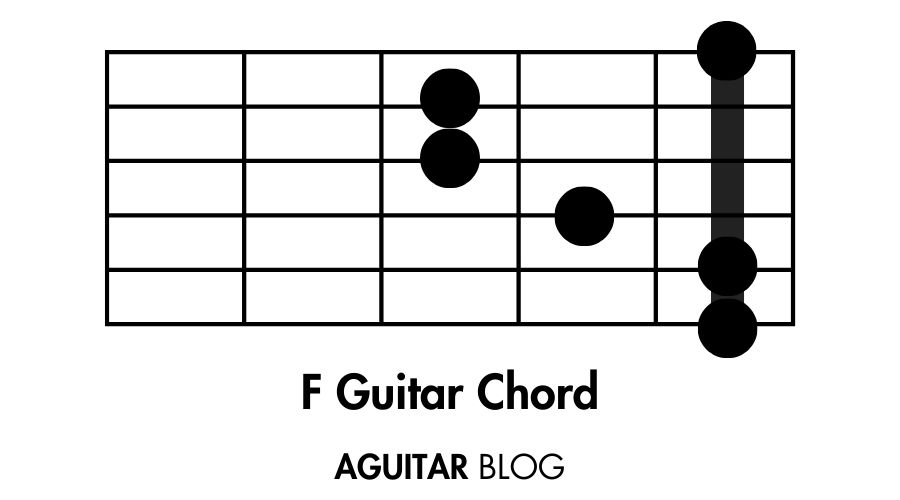The F guitar chord is one of the most challenging chords for beginners due to its barre shape, but it’s also one of the most rewarding to master. Whether you’re just starting out or looking to refine your technique, this guide will help you understand, play, and apply the F chord in your music.
What is the F Guitar Chord?
The F chord is a major chord built using three notes from the F major scale:
- F (root)
- A (major third)
- C (perfect fifth)
The F chord’s full-bodied sound makes it a cornerstone in many genres, from pop to classical.
How to Play the F Guitar Chord

Full Barre F Chord (1st Fret)
This is the standard way to play the F chord:
- Use your index finger to press down all six strings on the 1st fret.
- Place your middle finger on the 2nd fret of the G string.
- Place your ring finger on the 3rd fret of the A string.
- Place your pinky finger on the 3rd fret of the D string.
Strum all six strings. It takes strength and practice to press down all the strings cleanly, but it’s worth the effort.
Mini F Chord (Simplified Version)
A beginner-friendly alternative:
- Place your index finger across the 1st fret of the B and high E strings.
- Place your middle finger on the 2nd fret of the G string.
- Place your ring finger on the 3rd fret of the D string.
Strum only the top four strings. This version is easier to play but still sounds great.
Power Chord Shape (F5)
For a stripped-down rock version:
- Place your index finger on the 1st fret of the low E string.
- Place your ring finger on the 3rd fret of the A string.
- Place your pinky finger on the 3rd fret of the D string.
Strum just the low E, A, and D strings.
F Guitar Chord Variations
Once you’re comfortable with the basic F chord, try these variations to expand your sound:
- Fmaj7 (F Major 7): Adds a smooth, jazzy feel.
- F7 (F Dominant 7): Perfect for blues and funk.
- Fadd9: Bright and modern.
- Fsus4: Builds tension that resolves beautifully.
- Fm (F Minor): Creates a moody atmosphere.
Video Tutorial: Learn the F Guitar Chord
For visual learners, watching a step-by-step video can make understanding the F chord much easier. Check out this detailed tutorial that walks you through the finger placement, common mistakes, and strumming techniques:
Common Mistakes When Playing the F Chord
- Buzzing Strings: Ensure your fingers are pressing firmly and close to the frets.
- Muted Notes: Arch your fingers so they don’t accidentally touch adjacent strings.
- Strumming the Wrong Strings: For the mini F chord, avoid strumming the low E and A strings.
Tips for Practicing the F Guitar Chord
- Build Finger Strength: Practice the barre shape regularly to strengthen your index finger.
- Use a Capo: Place a capo higher on the neck to reduce string tension, then gradually move it down as you get stronger.
- Practice Switching Chords: Transition between the F chord and other common chords like C, G, or D.
- Break It Down: Start with the mini F chord before attempting the full barre chord.
Chord Progressions Featuring the F Guitar Chord
Here are some progressions to practice the F chord:
- Pop Progression: F – C – G – Am
- Blues Progression: F – Bb – C7
- Ballad Progression: F – Dm – Bb – C
Songs That Use the F Guitar Chord
The F chord is featured in many famous songs. Here are a few examples:
- “Hotel California” by The Eagles
- “Let It Be” by The Beatles
- “Good Riddance (Time of Your Life)” by Green Day
FAQ About the F Guitar Chord
1. Is the F chord hard to play?
Yes, it can be challenging for beginners due to the barre shape. However, practice and finger strength will make it easier over time.
2. Can I play the F chord without barring?
Yes! The mini F chord is a simplified version that doesn’t require a full barre.
3. How long does it take to master the F chord?
It depends on your practice routine. With regular practice, most beginners see improvement within a few weeks.
4. Why does my F chord sound bad?
Common issues include insufficient finger pressure, poor finger positioning, or accidentally muting strings. Take it slow and adjust your technique.
Conclusion
The F guitar chord may seem daunting at first, but mastering it is a significant milestone in your guitar journey. From its full barre shape to its simplified variations, the F chord unlocks countless musical possibilities. By practicing consistently and incorporating it into songs and progressions, you’ll soon find it an indispensable part of your repertoire.
